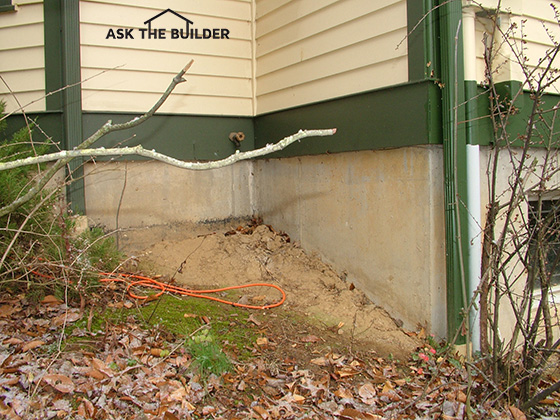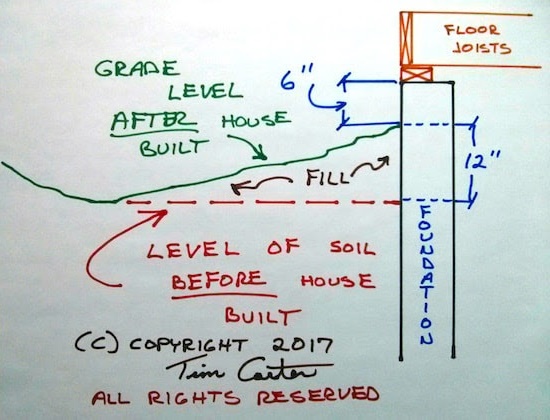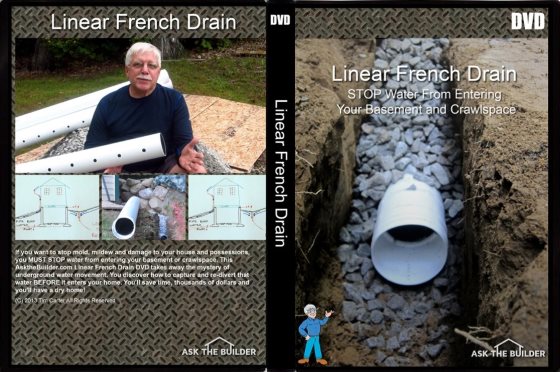Foundation Grade Level – Don’t Go Too Low!

Foundation Grade Level | You can see that more than 6 inches of the foundation wall are exposed above the orange extension cord. On the right side of the photo, the foundation height is about 36 inches high. This allowed for traditional basement windows to be installed to allow air and light into my basement. I built this home in 1986. © 2017 Tim Carter
Foundation Soil Grade Checklist
- Most foundations too deep in the ground
- Top of foundation 18 inches above grade
- Use excavated dirt to create an illusion of a low slope
- 6 inches of exposed foundation minimum
- CLICK HERE to Get Tim's FREE & FUNNY Newsletter!
Your home may be one that was buried too deep into the ground.
The builder dug the hole too deep. Based on my forty years of looking at, and building, house foundations, I'd say it happens nine times out of ten. This mistake causes all sorts of drainage problems around a house.
I've traveled all across the USA looking at foundations on houses built after WW II. Just about every one I see is too low. There's not enough slope around most homes to provide excellent drainage.
Builders from 140 years ago in many parts of the nation, knew how high to make foundations. More on that below.
New Construction
New homes and room additions are frequently the victims of poor planning with regard to grading. I can't tell you how many houses I have seen that were put too deeply into the ground.
This condition causes marshy ground, wet basements or flooded slabs. In virtually every case, a simple drawing or calculation would have solved the problem.
CLICK HERE to get FREE & FAST BIDS from local landscapers that can grade the soil around your home.
Make a Drawing
Many modern building codes have responded to this problem. They require that the top of foundations or slabs be at least 6 inches above the highest point of soil at any location around the house.
IMPORTANT TIP: This code requirement, as are ALL THINGS IN THE BUILDING CODE, is a MINIMUM requirement. This means you can increase the distance and give your home more protection.
Visit older neighborhoods in large cities east of the Mississippi River, and you'll frequently see the top of the stone foundations was about 36 inches above the grade or soil around the home!
Builders centuries ago knew that water would cause the wood frames and siding to rot, so they wanted the house up away from splashing rain.
Sloping Away
Furthermore, the ground must fall away from the foundation at least 6 inches within the first 10 feet around the perimeter of the house. Note that this is a minimum requirement. The more slope the better.

The top of your foundation should be 18 inches higher than nearby ground. Copyright 2018 Tim Carter
Using these calculations, this means that when laying out a new house, you need to pay attention to the existing grade before you dig.
In fact, you need to site the house and see just what the highest elevation of the ground is at any point within 10 feet of where the foundation will be. Knowing this, you can now begin to dig the foundation.
I always made a point to put the top of my foundations 18 inches above this highest point. You would be surprised how quickly the dirt from the hole disappears when spread out around the house. Although the foundation would look high prior to backfilling, the ground had a very gentle slope once all grading was completed.
In my opinion, you can never have too much slope away from your house. My guess is that anyone who has a wet basement or ground that slopes back towards their foundation will agree.
Existing Homes
Those of us with existing houses that have grade problems face different challenges. Landscaping, sidewalks and other improvements must be dealt with in trying to correct grade problems.
If you are lucky enough to have a sloped lot, your task of establishing grade can be accomplished. It may take a small piece of earth moving equipment like a Bobcat or skid-steer loader, but it will be worth it.
If you have a situation where ground is slopping towards your house (houses built on hillsides), the trick is to slope the ground gently by creating a swale. This swale, or ditch, allows you to do two things. It gets water away from the house and at the same time collects the water which runs downhill towards your house. You direct this swale around a corner of the house and continue until the natural slope of the ground is falling away from your structure.
CLICK HERE to get FREE & FAST BIDS from local landscapers that can grade the soil around your home.
Flat Lots
Those of you who live in houses on flat ground face a more serious challenge. Sometimes the ground is so flat that there is no way to easily create a swale or sloping condition.
See the above drawing I made to see a swale.
A swale is just a small valley in otherwise flat land.
Roof Water
In these cases, you need to pipe roof water as far away as possible. Downspouts that dump water onto the ground near the house can cause serious problems. You would be surprised at the volume of water a 1 inch rainfall can produce.
You can also consider surrounding your house with a hidden moat, something like the old castles used to have. This moat is simply a ditch that is dug around the problem areas of your house. I call it a linear french drain.

Do your own DIY install of a Linear French Drain with Tim Carter's time-tested methods and materials! CLICK IMAGE TO ORDER NOW!
This trench can be as narrow as 6 inches and work.
The depth of the trench depends on how much sub-surface water you want to collect and your local soil conditions.
In areas with heavy clay, the trench usually only needs to be 2-feet deep.
Once this trench is excavated, fill it to within 1 inch of the top with large 1 inch washed gravel. This trench acts as a collection area for surface water. As long as your soil can absorb water (even at a slow rate), you will have improved drainage conditions around your house.
Only in very wet seasons, when the water table rises around your house, will you experience problems.
CLICK HERE to get FREE & FAST BIDS from local landscapers that can grade the soil around your home.
Column B67
49 Responses to Foundation Grade Level – Don’t Go Too Low!